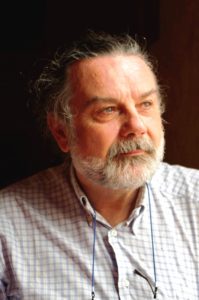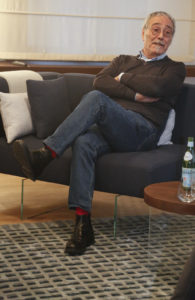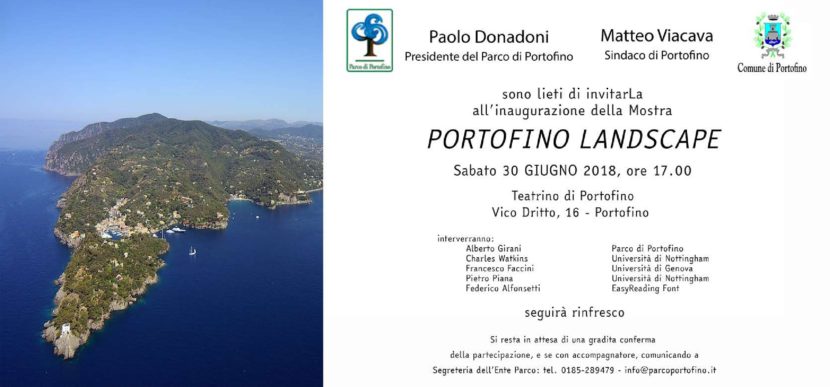- The fruits of the joint academic work between Italy and England
- The uniqueness of the coastal village on the Riviera di Levante seen by the University of Genoa and that of Nottingham
- The official EasyReading font of the Portofino Park a leading player of an exhibition opening on 30 June.
On the coming 30 June 2018 at 17.00hrs, the travelling exhibition PORTOFINO LANDSCAPE opens, giving a round up of the joint research work carried out by the Italian and English institutions over six months in the local area, with special attention paid to the point of view of the English visitors, who have always been keen visitors to the bay.
The exhibition, with free admission, was organised by the Municipality of Portofino and curated by Alberto Girani and Francesco Faccini of the University of Genoa – Department of Sciences of the Earth, of the Environment and of Lifeand by the Nottingham Leverhulme Project team, comprising Pietro Piana, Charles Watkins and Ross Balzaretti, of the School of Geography and Department of History.
The project managed to involve not only the academic environment, where it found fertile ground, but especially the residents of the village and its numerous visitors.
What was the idea behind a study like this? The awareness of the scale of uniqueness behind a landscape like that of the coastal village here on the Riviera di Levante, which has always been one of the most famous destinations for international tourists. The first stage of the exhibition will be in Portofino’s council-run Little Theatre, a jewel of maritime architecture, which has recently been refurbished and restored to its old splendour.
At the heart of the studies that brought about PORTOFINO LANDSCAPE, there is the Park, which has been protected since 1935 and even today gives witness to the profound, and to a certain extent complex, interaction between Man and his environment, which can be seen in the most important characters of the scenario that it presents, an icon representative of Italy. The exhibition includes documents of various kinds (pictures, drawings, old and new photos, written source material and old cards), which can all reveal to the interlocutor how much history lies behind a mosaic of panels, which mainly aim to reconstruct relationships and interactions that have contributed to a changing landscape over the centuries. The exhibition was conceived in Italian and English and consists of 27 panels in portrait format, each measuring 1 m by 70 cm, prepared and printed by Parco di Portofino.

The director of the Portofino Park Alberto Girani takes us behind the scenes at PORTOFINO LANDSCAPE: «This is an innovative project because it was created from a local area which is studied from various points of view. The backing of the University of Nottingham was important, because it threw new light on drawings, paintings and watercolours, down to the materials used by the guides to access English culture in recounting the landscape value of Portofino and its success. We thought of providing anyone who is interested with a barrage of ideas that cannot fail to lead to reflecting on the current value of certain Italian landscapes. We will help you dig out the roots and reasons underlying the value which, although it can be felt, deserves discussion. This is not an exhibition following Cartesian discipline, so do not expect to find a logical route with something proven at the end, but rather an exhibition aiming to highlight the value that is in play here and which needs safeguarding, on the one hand, and bringing to life, on the other, with all the critical issues arising from this».
How did the cooperation with Charles Watkins, of the University of Nottingham, come about?
«Charles is a lecturer in Rural Geography at the Faculty of Social Sciences of the University of Nottingham and how we met is almost quite touching. Apart from managing the Portofino park, I am a lecturer at the University of Genoa. Pietro Piana, one of the exhibition authors, from being a friend of my daughter, became one of my students on a course of Planning of protected areas. He was an excellent student and passed the exam with top grade, with honours. After his three-year degree course, when he was followed by my friend and colleague Francesco Faccini, who is also one of the authors of Portofino Landscape, he ended up in my course of specialisation. He then needed to work in the field, but we had no openings for him to work, so between universities we decided to open a path for this talented young man and we offered him to Charles Watkins, who took him under his wing at Nottingham and refined his talent, until one day he called to tell me that he wanted to do something together with me. We all met several times and a feeling grew up immediately and this is the first fruit of our work. It is a light exhibition, arising from a meeting of visions, from a desire to leave a mark, more than restricting ourselves to informing, that is why the approach we chose was cultural. We selected pieces of history of the Portofino landscape, to see what effect this would have on people; our opinion counts, of course, but we are still specialists and what we want is to speak to the ordinary people».
In common with the Portofino Park, this exhibition also shares the font used for all the panels and informative material: EasyReading. Why did the choice fall on them?
«Ours is an ideological and communicative choice, because we need sharing to be immediate, clear and, above all, aimed at everyone, without distinction, and just as I chose EasyReading for the Portofino Park, in this case too the choice could not be other than for the inclusive character created by the designer, Federico Alfonsetti, who will be here together with the rest of the team for the inauguration on the coming 30 June in Portofino. We are talking about the only character that can help someone who may have difficulty, apart from making life easier for normal readers, and I would add, by the way, that between September and October the exhibition will be in Nottingham; we are waiting for the exact details from the University on availability, but Portofino Landscape is flying to England, together with EasyReading, and may also be enriched by a photographic exhibition, to show what is not on direct display in the English Midlands: the beauty of Portofino and the beauty of Italy».

Federico Alfonsetti, EasyReading designer, will be one of the speakers on this coming 30 June in the coastal village of the Riviera di Levante for the inauguration of PORTOFINO LANDSCAPE: «The Portofino Park was one of the first in Italy to introduce our font, showing how far-sighted the director Alberto Girani was at the time, and with the passing of the years it is nice to see these relationships growing and giving new fruits. It is an immense pleasure for our team to be involved in international projects, which may have a strong academic basis but nevertheless aim to speak to the public, to youngsters, to tourists and to anyone who will be given the chance, every day, to come into contact with the studies and the wonders that such fine thinking minds have been able to bring out. Speaking to everyone, without distinctions, and being understood by everyone, without misunderstanding, is the most beautiful thing that can be done today and that is what our idea of improvement revolves around».

